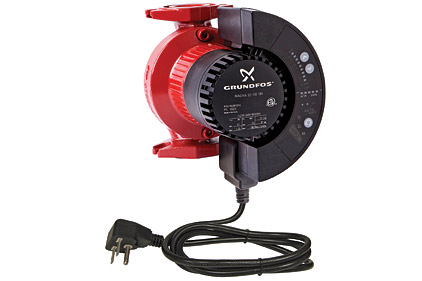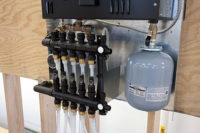First of all, how does a contractor know how to design and install a heating system utilizing the proper equipment? One of the best ways is to use a software program that specifically customizes a system to each home or building. For example, let’s say you are specifying a radiant heat system for a client. A program like Right-Suite® Universal from Wrightsoft enables users to adjust layouts through defining preferences and using the drag-and-drop method. This software combines industry-standard ASHRAE calculation methods and design techniques to provide a comprehensive design and calculation tool.
Designers can adjust to a desired radiant heating system based on several factors, such as whole-building or room configurations, manifold piping connections, loop patterns, and spacing. Then, products can be added from recognized radiant panel component manufacturers, or designers can customize using their own preferences.
Using this software, HVAC contractors can create tailored proposals with up to three systems to select from which are automatically generated based on the system specifications and their parts and pricing. These proposals can be customized to include a contractor’s logo and any extra verbiage.
“Right-Suite makes creating my designs much easier, and with the Right-Radiant module, I’m able to change my layout patterns at the click of a button and see immediate results,” said Nate Johnson of Plumbing and Heating by Craig Hutchinson. “The program’s built-in calculations automatically determine different water temperatures and feet of head requirements when necessary. And, by having the Right-Proposal module, my parts takeoff list is instantly generated from my design.”
Now for the Components
If you have a good handle on system design, the next step is to choose the right components. For example, a lot of mechanical equipment is being downsized today to fit into more compact spaces. Gone are the days of clunky mechanical monsters looming in dark, dingy basements. Today you can find esthetically pleasing equipment hanging on walls or in closets. One example is the Eternal GU100 hybrid water heater from Eternal.
The Eternal is small (about the size of a small carry-on suitcase) and a flexible design allows the unit to be placed indoors, outdoors, mounted on a wall, or placed on the floor. In small homes where space is limited, the homeowner can move the water heater to another location and use the utility closet for something else (like storing equipment or household items). With the Eternal hybrid, homeowners get a high efficiency system that provides continuous hot water and adequate water pressure. For a homeowner, this means they can be the first person in the shower or the last and still get a hot shower. It supports multiple applications without sacrificing water pressure. The customer no longer has to plan when they will use hot water and they can multitask too. They can run the dishwasher, shower, and do the laundry at the same time.
For contractors, it is all about ease of installation, too. The Eternal uses standard water connectors on top of the unit, it is vented with 2-inch or 3-inch schedule 40 PVC, and it can be power vented or direct vented. Since the Eternal GU100 runs on a ½-inch gas line, a contractor will not have to increase the gas when they remove a standard tank to replace it with an Eternal.
Speaking of compact size, the Utica SSC boiler is a contractor’s friend. The lightweight (111 pounds), compact, wall-mount boiler is replacement ready with 1 1/4 inch NPT connections, and available in 50 to 200 MBtu capacities. With a 96 percent AFUE rating, its sealed combustion and outdoor temperature reset make a big difference in fuel costs to a homeowner versus an older, low efficiency heating system which can have an AFUE as low as 70 percent. By constantly adjusting the flame input, the boiler is only using the necessary amount of fuel to provide heating comfort.
“It is simple, and easy to understand with Utica dependability,” said HVAC contractor Wayne Buggeln of Buggeln Brothers Inc.
Ease of installation and product size are two important selling features of hydronic equipment. Efficiency and energy savings are two more. Intelligent or smart pumps such as the Grundfos Magna™ represent an ability to automatically modulate circulator performance to match ever-changing system demand.
The variable-speed wet rotor Magna circulator uses an integrated logic algorithm to learn a system’s usage patterns to automatically determine the lowest possible operating efficiency point to maintain the desired temperature. By continuously fine tuning power consumption and flow rates to meet the dynamic needs of the system, this Autoadapt function saves both energy and money.
Power consumption represents 85 percent of a pump’s lifetime costs. Therefore, even the smallest improvement in energy efficiency can translate into sizeable cost savings over the 15-year average pump lifespan. In fact, some of today’s leading integrated, variable-speed circulators offer payback in as little as two years. These pumps are designed for air conditioning and heating systems in buildings on any scale, including apartments, schools, hospitals, hotels, as well as light commercial applications.
It’s not unusual for products from manufacturers like Grundfos to become integral parts of other hydronic product lines, too.
For example, the Grundfos three-speed, SuperBrute pump is included in Noritz tankless hydronic boilers. These boilers combine several pumps into one, providing multiple pump curves, rather than the one-pump curve of a typical single-speed pump. “The multiple pump curves make it easier to correct flows and pressure losses, allowing the hydronic boiler to better adapt to changing demand in a home heating system,” said Ray Rasalan, product coordinator/developer for Noritz.
“The number one problem with many boilers on the market today is that smaller, undersized pumps are used with hydronic boilers to fit applications that require larger pumps. In many cases, the smaller pump cannot be returned and a larger one needs to be purchased.”
There are many other products that go into an energy-efficient hydronic heating system, including controls. One example is the AquaSmart™ from R.W. Beckett. Offering the AquaSmart is a way for contractors to upgrade their customer’s boiler control to give customers a real and relatively low-cost way of saving money. This product should have a payback period of less than a year, depending on product and installation costs. Building owners may not be able to afford a new boiler but they can realize significant savings from installing an AquaSmart. It casts the contractor in a positive light by providing them a solution to offer their customers to save them money.
Key features of the AquaSmart are its state-of-the-art design, ease of programming, 2N1 low-water cut off probe, and Heat Manager Economizer. Contractor Robert O’Brien of Technical Heating Co. LLC said, “I’ve been using the AquaSmart exclusively for over two years for both retrofit and new installations. It has demonstrated significant savings and outstanding performance with zero issues.”
Other key components in a hydronic heating system are the “support products” such as an underfloor heating plate. And with new construction activity depressed and a sharp focus on energy savings, there is an opportunity for products that combine value (in new construction or remodels) and the ability to use lower-temperature hot-water sources.
Watts Radiant/SunTouch’s FlexPlate is a flexible graphite plate designed for underfloor, wall, or ceiling applications. The high thermal conductivity (50 percent higher than aluminum) of the graphite allows it to better utilize high-efficiency, low-temperature heat sources. The plates are good for new construction or retrofits.
The lightweight, flexible plates can be cut with a pair of scissors or utility knife and don’t have any sharp edges that require grinding. According to John Sweaney, of Watts Radiant/SunTouch, “FlexPlate allows HVAC contractors to offer lower temperature radiant systems in remodels, opening up a significant market to the comfort and efficiency of radiant.”
HVAC contractors have many choices of hydronic heating equipment, and these are a few examples of how knowledge of wet heat technology can make the selling job a little easier. Being a wet heat expert just got a lot easier.
Publication date: 2/20/2012







